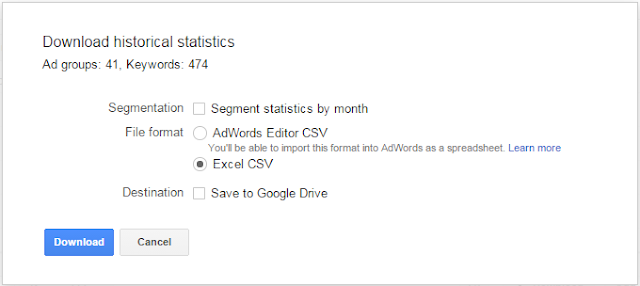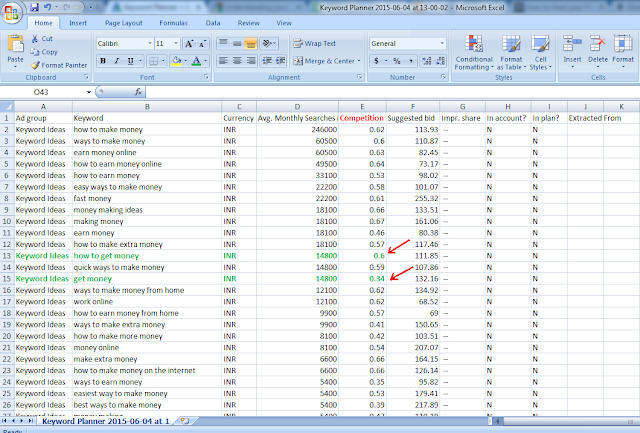The Google keyword planner is undoubtedly the No.1 keyword research tool where you can find the most perfect keywords (both long tail and short tail) for your upcoming SEO campaign. Although, there are many paid and advance keyword tools are available on the internet for deeper research purpose, still I recommend the Google Keyword Planner as it displays Google’s core search data.
Not only that, if you know- how to use Google keyword planner properly, then this tool will provide you more accurate keyword competitive analysis data which are easily comparable with any paid version keyword tool.
We're generally using the Google Keyword Planner to get new keywords ideas, comparing its search volume and competition. But, the problem is, here you can only separate your suitable keywords by only three competitive analysis terms- High, Medium and Low. Here you can’t estimate how actually your keywords are competitive!
For instance, the two keywords- ‘how to get money’ and ‘get money’ both has Average monthly searches- 14,800 and both are “Medium” competitive. Now, which one you should choose? It’s really a tough job for you if you have a money blog. See the picture (click to enlarge).
Do you know that the Google Keyword Planner allows accessing its actual keyword competitive data in Excel CSV format? You can access the actual keyword competitive data by downloading the historical statistics of your keyword ideas.
Google evaluates competition for a particular keyword by the rational numbers between 0.01 to 1 (know more about keyword competition here). Here is an estimated formula- how Google separates keywords for the Low, Medium and High competitive level.
After downloading the historical statistics of your keyword ideas from the upper-right corner of the chart (don’t forget to download it in Excel CSV format), you can see your all expected keywords and its analysis data in an office Excel sheet.
For instance, I’ve downloaded the analysis data of the keyword- 'make money online', to show you- how easily you can separate the two medium competitive keywords ‘how to get money’ and ‘get money’ both with an average monthly search volume 14,800. See the screenshot below (Click to enlarge the picture).
According to the Google Keyword Planner Excel CSV data-
The keyword- ‘how to get money’ is under the competition-number- 0.6, and the keyword- ‘get money’ is under the competition-number- 0.34 (Green highlighted rows).
Here, obviously, the keyword with lower competition- number will rank better in Google search. So, you should choose the keyword 'get money' as it under a much lower competition-number. It's the actual procedure of keyword research using the Google Keyword planner!
I also recommend using Keyword Filters (Find new keywords >> Search for new keywords using a phrase, website or category>> Customize your search>> Keyword filters) to sort your search by High, Medium or Low competitive keywords.
Related Post:
Not only that, if you know- how to use Google keyword planner properly, then this tool will provide you more accurate keyword competitive analysis data which are easily comparable with any paid version keyword tool.
Google keyword planner to get more accurate competitive analysis data;
We're generally using the Google Keyword Planner to get new keywords ideas, comparing its search volume and competition. But, the problem is, here you can only separate your suitable keywords by only three competitive analysis terms- High, Medium and Low. Here you can’t estimate how actually your keywords are competitive!
For instance, the two keywords- ‘how to get money’ and ‘get money’ both has Average monthly searches- 14,800 and both are “Medium” competitive. Now, which one you should choose? It’s really a tough job for you if you have a money blog. See the picture (click to enlarge).
Keyword Competition; Deeper Analysis Process;
Do you know that the Google Keyword Planner allows accessing its actual keyword competitive data in Excel CSV format? You can access the actual keyword competitive data by downloading the historical statistics of your keyword ideas.
Google evaluates competition for a particular keyword by the rational numbers between 0.01 to 1 (know more about keyword competition here). Here is an estimated formula- how Google separates keywords for the Low, Medium and High competitive level.
| Numbers | Completion Statistics |
| 0.01 to 0.33 (apx) | Low |
| 0.34 to 0.67 (apx) | Medium |
| 0.67 to 1.0 (apx) | High |
After downloading the historical statistics of your keyword ideas from the upper-right corner of the chart (don’t forget to download it in Excel CSV format), you can see your all expected keywords and its analysis data in an office Excel sheet.
For instance, I’ve downloaded the analysis data of the keyword- 'make money online', to show you- how easily you can separate the two medium competitive keywords ‘how to get money’ and ‘get money’ both with an average monthly search volume 14,800. See the screenshot below (Click to enlarge the picture).
According to the Google Keyword Planner Excel CSV data-
The keyword- ‘how to get money’ is under the competition-number- 0.6, and the keyword- ‘get money’ is under the competition-number- 0.34 (Green highlighted rows).
Here, obviously, the keyword with lower competition- number will rank better in Google search. So, you should choose the keyword 'get money' as it under a much lower competition-number. It's the actual procedure of keyword research using the Google Keyword planner!
I also recommend using Keyword Filters (Find new keywords >> Search for new keywords using a phrase, website or category>> Customize your search>> Keyword filters) to sort your search by High, Medium or Low competitive keywords.
Related Post:














0 comments:
Post a Comment